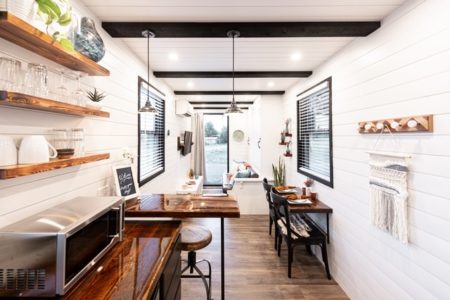If you want to frighten yourself, type “world population clock” into Google. The figures go up with terrifying speed: the number (as this article was started) was 7,900,635,185 – rapidly approaching 8bn.
In the UK, the latest population figure is 68.32m, but wherever people live, one thing is self-evident: we are going to need more homes in the future. Increasingly, what are known as “tiny homes” are being seen as the answer – not just to ever-increasing populations, but to more people living alone, and the finite amount of space that is available.

First things first. What is a tiny home? According to the tiny house movement a tiny home is defined as a “dwelling unit with a maximum of 37 square metres (400 square feet) of floor area, excluding lofts. Your first thought might be: ‘Six metres by six? That’s bigger than my lounge. Not so tiny after all…’
Then you consider that it has to cover a kitchen, a bathroom, somewhere to live, somewhere to sleep – and maybe it is not so big after all.
Another key element of the tiny house movement, which goes some way to explaining its growing popularity, is its commitment to sustainability. Many people opting to live in tiny homes, especially post-pandemic, have reassessed what they want from life and want a more eco-friendly solution to their housing needs. Built with eco-friendly materials almost always including high-quality insulation and only needing a very small plot of land, tiny homes exactly tick this box.
The other huge advantage of a tiny house is, of course, affordability. Depending on which source you use the average price of a house in the UK is a little over £250,000. According to the Tiny Housing Co. the average price of a tiny house is just £55,000.
In our home town of Brighton & Hove, the smallest property currently on Rightmove is just 9 square metres (97 square feet), currently on the market for £80,000 to cash buyers only (it’s too small for mortgage lenders). Maybe not so bad for a midweek bolt-hole for a worker, but hardly healthy for a permanent residence.
As we noted above, virtually all countries face the problem of an increasing population. What they also face is a big demand for housing in certain regions – in the UK London and the South East is the obvious example. In areas like this even traditional “affordable housing” (defined by the Government as houses sold at 80% of average market value) may not be that affordable. If the average price in your area is £300,000 then an ‘affordable home’ at £240,000 could still be a long way out of your price range.
All this goes a long way towards explaining the ever increasing popularity of tiny homes. When you factor in the number of people re-assessing what they want from work and life in the wake of the pandemic, we’re certain to see far more tiny homes in the future as populations continue to increase.
…Speaking of which, the population of the world is now 7,900,637,540. In the time it took to write this article, the population of our planet increased by 2,355.
If you’re looking to become a homeowner, move house or get a better deal on your existing mortgage we’d love to hear from you. Get in touch and we’ll be help you understand what’s possible, or sign up to our monthly newsletter, to keep your finger on the pulse.
Sam Murphy – 18th October 2021
Sources
https://www.thetinyhousing.co/blog/tiny-houses-the-future-to-affordable-housing









 Production
Production